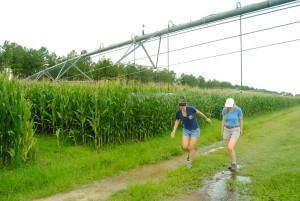 It should come as no surprise that climate change is a serious threat and that adaptation measures are key to lessening its impacts. But for Kirsten Howard and Allie Goldstein, recent graduates of the University of Michigan’s School of Natural Resources and the Environment, it wasn’t enough for them to learn that climate change adaptation is important. Howard and Goldstein wanted to know, what does climate change adaptation actually look like? And so they set out on a road trip to find out how local actors– from city planners to farmers to community activists– are adapting their lives and practices to build their resilience to climate change impacts.
It should come as no surprise that climate change is a serious threat and that adaptation measures are key to lessening its impacts. But for Kirsten Howard and Allie Goldstein, recent graduates of the University of Michigan’s School of Natural Resources and the Environment, it wasn’t enough for them to learn that climate change adaptation is important. Howard and Goldstein wanted to know, what does climate change adaptation actually look like? And so they set out on a road trip to find out how local actors– from city planners to farmers to community activists– are adapting their lives and practices to build their resilience to climate change impacts.
So far, Howard and Goldstein have journeyed to New England, where they did a story on how farms in Vermont are adapting to the impacts of Tropical Storm Irene, and to Cape Cod where they learned the creative ways local officials there are working to save parking lots that are eroding due to waves and storms. They then journeyed down through the mid-Atlantic where they chatted with farmers in Georgia who are developing efficient irrigation methods to confront impending droughts, and then down to the bayou, where they engaged with shrimpers, coastal geologists and others about wetland loss in Louisiana– the fact that the state is losing an equivalent of a football field of land every 38 minutes. The pair has also explored adaptation efforts in Santa Fe and Denver, and are now making their way up the west coast, where they’ll soon do a story on vineyards in Napa and on impending ocean acidification and its impact on the shellfish industry in the Olympic Peninsula in Washington. From there they’ll continue to explore adaptation in action in Glacier National Park and Nebraska before ending up back in Ann Arbor in mid-August.
Howard and Goldstein have learned a lot along the way, but have been most impressed by how much people care and how this care motivates them into action. The impacts of climate change— from sea level rise to increased risk of forest fire to extreme heat to changing precipitation patterns to more intense and frequent storms— and therefore the solutions, are different depending on location, climate, resources, etc. Nonetheless, the pair has found one constant along the way: people care. Even if people are not engaged in larger conversations on climate change, they care about the particular issues occurring in their hometowns and are not waiting for Congress to finally, maybe, one day, do something about it. Rather, people are actively engaging in the issues in their towns, implementing new technologies and policies that are furthering adaptation efforts. Goldstein said that, even in the absence of meaningful national climate policy, these local pursuits are “giving [her] hope.”
When asked what’s the most revelatory or interesting bit they’ve uncovered thus far, Howard offered that she was surprised to learn that communities are pursuing resiliency efforts for many reasons—not all of them directly related to climate change adaption. Howard explained that there are many different motivations for this work, and what’s great is that many adaptation measures have impacts that go well beyond combating climate change. For example, the city of Baltimore is working on building its urban tree canopy, but not just because trees encourage storm water filtration and lessen the impacts of urban heat islands. Trees also provide health benefits and aid in crime reduction efforts, other ways that help improve the city overall.
Important to note too, is that their road trip isn’t just any old road trip; rather, it’s a road trip by blog. That is, the pair recognized that there is an important human element to their endeavor: People are moved by stories. By engaging readers in place and people, Howard and Goldstein hope that their stories will not only pique people’s interest, but actively encourage them to get involved in climate change adaptation efforts and/ or support the efforts happening in their local community.
When all is said and done, Howard and Goldstein hope to package the blog posts into an e-book and to find other ways to get their stories to practitioners, such as by contributing case studies to the Climate Adaptation Knowledge Exchange and the Georgetown Climate Center’s Adaptation Clearinghouse. What’s for sure is that both Howard and Goldstein now have a much better picture of what climate change adaptation “looks like,” and they’re not going to let anyone forget.
To follow their adaptation adventures, and to see if they’re coming to a town near you, check out: http://adaptationstories.com.




